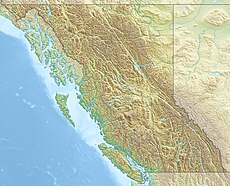Mount Haig
| Mount Haig | |
|---|---|
 North aspect from Castle Mountain Resort ski area | |
| Highest point | |
| Elevation | 2,610 m (8,560 ft)[1] |
| Prominence | 685 m (2,247 ft)[2] |
| Listing | |
| Coordinates | 49°17′20″N 114°26′50″W / 49.28889°N 114.44722°W[3] |
| Geography | |
| Country | Canada |
| Provinces | Alberta and British Columbia |
| Parent range | Clark Range[4] |
| Topo map | NTS 82G7 Flathead Ridge[3] |
Mount Haig is located on the border of Alberta and British Columbia on the Continental Divide. It was named in 1862 after Haig, Captain R.W.[4][2] Mount Haig is the highest peak of Gravenstafel Ridge; its lower north and east faces feature as back country cat skiing for Castle Mountain Resort on neighbouring Gravenstafel Mountain.
Geology
Mount Haig is composed of sedimentary rock laid down during the Precambrian to Jurassic periods. Formed in shallow seas, this sedimentary rock was pushed east and over the top of younger Cretaceous period rock during the Laramide orogeny.[5]
Climate
Based on the Köppen climate classification, Mount Haig is located in a subarctic climate with cold, snowy winters, and mild summers.[6] Winter temperatures can drop below −20 °C with wind chill factors below −30 °C.

See also
References
- ^ "Topographic map of Mount Haig". opentopomap.org. Retrieved 2022-06-19.
- ^ a b "Mount Haig". Bivouac.com. Retrieved 2010-02-19.
- ^ a b "Mount Haig (Alberta)". Geographical Names Data Base. Natural Resources Canada. Retrieved 2022-06-19.
- ^ a b "Mount Haig". cdnrockiesdatabases.ca. Retrieved 2019-08-20.
- ^ Gadd, Ben (2008), Geology of the Rocky Mountains and Columbias
- ^ Peel, M. C.; Finlayson, B. L.; McMahon, T. A. (2007). "Updated world map of the Köppen−Geiger climate classification". Hydrol. Earth Syst. Sci. 11: 1633–1644. ISSN 1027-5606.
External links
- Mount Haig: Mountain-forecast.com


